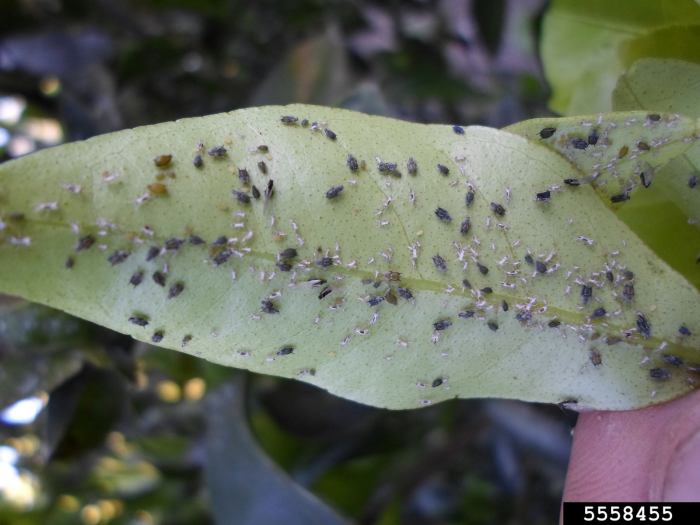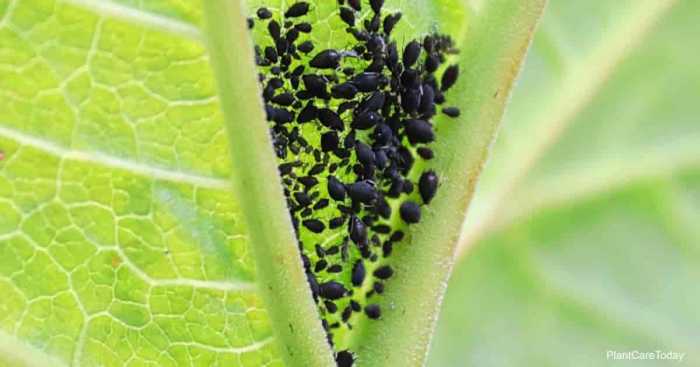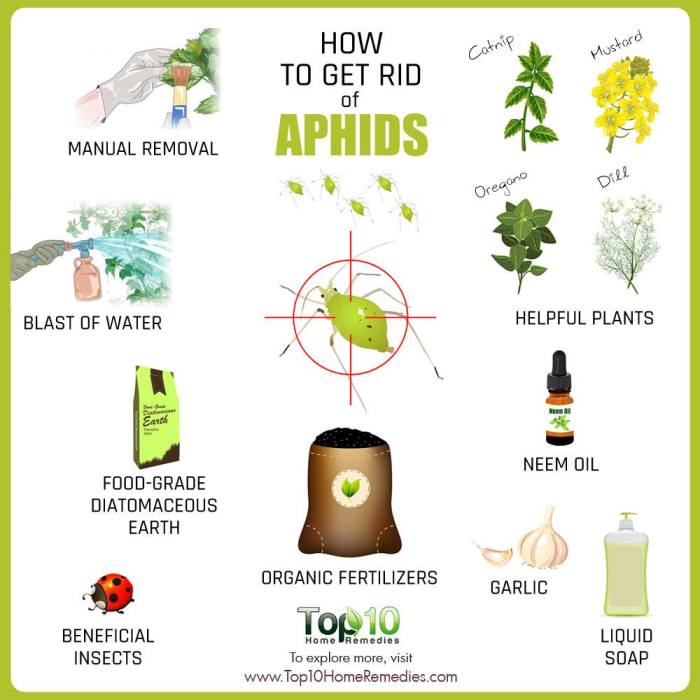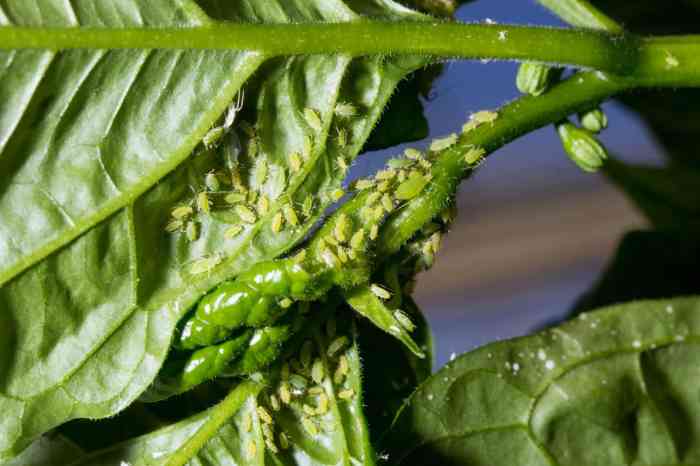How to get rid of aphids on houseplants – Those pesky aphids are a common sight on houseplants, and while they might look harmless, they can quickly suck the life out of your beloved greenery. These tiny insects can multiply rapidly, leading to a full-blown infestation if left unchecked.
But don’t despair! With the right knowledge and a few simple techniques, you can effectively control and eliminate these plant-munching pests.
From understanding their lifecycle to exploring various control methods, this guide will empower you to protect your houseplants from aphids and keep them thriving.
Understanding Aphids: How To Get Rid Of Aphids On Houseplants

Aphids are tiny, soft-bodied insects that are a common pest of houseplants. They feed on the sap of plants, which can cause damage and weaken your plants. Understanding their lifecycle and the signs of infestation can help you effectively combat these pesky insects.
Lifecycle of Aphids
Aphids reproduce rapidly, with a complex lifecycle involving both sexual and asexual reproduction. Female aphids can give birth to live young without mating, producing several generations in a short period. This rapid reproduction allows aphid populations to grow quickly. Aphids can also reproduce sexually, laying eggs that hatch in the spring.
Impact of Aphids on Houseplants
Aphids feed on the sap of plants, extracting nutrients and causing damage to leaves, stems, and buds. This feeding can lead to:* Curled or distorted leaves:Aphids feeding on leaves can cause them to curl or become distorted, affecting the plant’s growth and appearance.
Yellowing or wilting leaves
As aphids extract sap, leaves may lose their vibrant color and become yellow or wilt due to nutrient depletion.
Sticky residue
Aphids excrete a sticky substance called honeydew, which can coat the leaves and attract other pests like ants and sooty mold.
Stunted growth
Infestations can hinder the plant’s growth and development, affecting its overall health and vigor.
Signs of Aphid Infestation
Identifying aphid infestation early is crucial for effective control. Here are some common signs:* Small, soft-bodied insects:Aphids are tiny, usually less than 1/8 inch long, and have pear-shaped bodies. They can be green, black, brown, or even reddish.
Clumps of aphids
Aphids often gather in large numbers on the underside of leaves, stems, and buds.
Sticky honeydew
The sticky residue left by aphids can be seen on the leaves and surrounding surfaces.
Ants
Ants are attracted to honeydew, so their presence can indicate an aphid infestation.
Sooty mold
The sticky honeydew can attract sooty mold, which appears as a black, powdery substance on leaves.
Houseplants Susceptible to Aphids
While aphids can affect many houseplants, some are particularly susceptible:
- African Violets:These delicate plants are often targeted by aphids, which can damage their delicate leaves and flowers.
- Ficus:Ficus plants, like the popular Ficus benjamina (Weeping Fig), are known to be susceptible to aphid infestations.
- Pothos:This popular vining plant is also susceptible to aphids, which can damage its leaves and growth.
- Roses:While not technically a houseplant, indoor roses are also susceptible to aphid infestations.
- Citrus:Indoor citrus trees, like lemon or orange trees, can be affected by aphids, which can cause leaf drop and fruit damage.
Prevention Strategies

The best approach to dealing with aphids is to prevent them from infesting your houseplants in the first place. By implementing some simple preventive measures, you can significantly reduce the risk of these pesky insects taking over your beloved greenery.Preventing aphid infestations is all about creating an environment that is less hospitable to them.
This includes maintaining good plant hygiene, inspecting your plants regularly, and understanding how environmental factors can influence their presence.
Plant Hygiene
Maintaining good plant hygiene is crucial for preventing aphid infestations. Aphids can easily spread from one plant to another, so it’s important to keep your plants clean and free of debris.
- Regularly wipe down leaves with a damp cloth to remove any dust or sticky residue that could attract aphids.
- Inspect new plants carefully before introducing them to your collection. Quarantine them for a few weeks to ensure they are free of pests.
- Remove any dead or dying leaves promptly, as they can provide a breeding ground for aphids.
- Avoid overcrowding your plants. Adequate spacing allows for better air circulation, which can help deter aphids.
Regular Inspections
Regular inspections are essential for catching aphid infestations early on. Aphids are small and can be difficult to spot, but with careful observation, you can detect them before they become a major problem.
- Examine the undersides of leaves, as this is where aphids tend to congregate.
- Look for any signs of discolouration, yellowing, or wilting, which can indicate an aphid infestation.
- Check for sticky honeydew, a sugary substance excreted by aphids, which can attract other pests.
Environmental Factors
Environmental factors play a significant role in aphid infestations. Understanding these factors can help you create a less hospitable environment for aphids.
- Temperature:Aphids thrive in warm temperatures. Keeping your houseplants in a cool environment can help deter them.
- Humidity:Aphids prefer dry environments. Increasing humidity can help control aphid populations.
- Light:Aphids are attracted to light. Ensure your plants receive adequate sunlight, but avoid placing them in direct sunlight, which can create a warm, dry environment that aphids prefer.
Natural Control Methods

After addressing prevention strategies, let’s delve into effective natural methods for tackling aphid infestations on your beloved houseplants. These methods prioritize the well-being of your plants while minimizing the use of harsh chemicals. They often involve leveraging nature’s own solutions to restore balance to your indoor ecosystem.
Using Insecticidal Soap
Insecticidal soap is a safe and effective option for controlling aphids. It works by disrupting the outer layer of the insects, leading to dehydration and death.
| Method | Description | Application | Effectiveness |
|---|---|---|---|
| Insecticidal Soap | A soap-based solution that disrupts the outer layer of aphids, causing dehydration and death. | Spray the soap solution directly onto the aphids, ensuring thorough coverage of all affected areas. Repeat application as needed, typically every 7-10 days. | Effective in controlling small aphid infestations. |
Applying Neem Oil, How to get rid of aphids on houseplants
Neem oil, extracted from the neem tree, is a natural insecticide that effectively controls aphids. It disrupts the insects’ feeding and reproductive cycles, ultimately leading to their demise.
| Method | Description | Application | Effectiveness |
|---|---|---|---|
| Neem Oil | A natural oil extracted from the neem tree that disrupts aphid feeding and reproduction. | Dilute neem oil according to product instructions and spray thoroughly onto the affected plants, ensuring coverage of both the leaves and stems. Repeat application as needed, typically every 7-14 days. | Highly effective in controlling aphid infestations, particularly when used consistently. |
Introducing Beneficial Insects
Certain beneficial insects, such as ladybugs and lacewings, are natural predators of aphids. Introducing these insects into your indoor environment can help control aphid populations without the need for chemical intervention.
| Method | Description | Application | Effectiveness |
|---|---|---|---|
| Beneficial Insects | Predatory insects, like ladybugs and lacewings, that feed on aphids, naturally controlling their populations. | Purchase beneficial insects from reputable suppliers and release them near the infested plants. Provide suitable habitats, such as flowering plants, to encourage their presence. | Highly effective in controlling aphid populations over time, especially when combined with other natural methods. |
Using a Strong Water Spray
A strong jet of water can dislodge aphids from plants, helping to reduce their numbers. This method is particularly effective for young aphids or those located on the underside of leaves.
| Method | Description | Application | Effectiveness |
|---|---|---|---|
| Strong Water Spray | Using a strong jet of water to dislodge aphids from plants. | Direct a strong stream of water from a hose or watering can onto the infested plants, focusing on the underside of leaves where aphids tend to congregate. | Effective in dislodging aphids, but may not be sufficient for controlling large infestations. |
Using Diatomaceous Earth
Diatomaceous earth, a fine powder made from fossilized diatoms, is a natural insecticide that dehydrates and kills aphids. It works by creating microscopic cuts in the insects’ exoskeletons, leading to dehydration and death.
| Method | Description | Application | Effectiveness |
|---|---|---|---|
| Diatomaceous Earth | A fine powder made from fossilized diatoms that dehydrates and kills aphids. | Dust diatomaceous earth around the base of plants and on the underside of leaves, ensuring thorough coverage. Avoid using food-grade diatomaceous earth, as it is intended for human consumption. | Effective in controlling aphids, particularly when used consistently. |
Chemical Control Methods

If you’ve tried all the natural methods and the aphid infestation persists, or you’re dealing with a severe outbreak, you might consider using chemical insecticides. However, it’s crucial to understand the risks and use these products responsibly.
Using chemical insecticides should always be the last resort. They can harm beneficial insects, pets, and even humans if not used properly. It’s essential to read and follow the instructions on the product label carefully, including safety precautions and application methods.
Aphids can be a real pain, especially when they infest your beloved houseplants. I find that a gentle spray of soapy water works wonders, but if you have a more serious infestation, you might want to consider introducing some natural predators, like ladybugs.
You can even attract them to your backyard with flowering plants, and then release them into your home to take care of the aphids. Just make sure to keep the plants away from any pets or children, and you’ll be back to enjoying healthy, pest-free houseplants in no time!
Types of Insecticides
Insecticides are designed to kill insects. They come in various forms, each with its advantages and disadvantages. Here’s a breakdown of common types:
- Insecticidal Soaps:These are derived from natural oils and are generally considered safer than synthetic insecticides. They work by disrupting the cell membranes of insects, causing them to dehydrate and die. Insecticidal soaps are effective against aphids but are less persistent than other options.
- Neem Oil:Extracted from the neem tree, neem oil is a natural insecticide with insecticidal and anti-fungal properties. It works by disrupting the insect’s growth and reproduction cycle. Neem oil is considered relatively safe for humans and pets but can be harmful to some beneficial insects.
- Pyrethroids:Synthetic insecticides derived from chrysanthemum flowers, pyrethroids are highly effective against a wide range of insects, including aphids. They work by disrupting the nervous system of insects, causing paralysis and death. However, pyrethroids can be toxic to beneficial insects and pets, and some people may experience allergic reactions.
- Neonicotinoids:These are a class of synthetic insecticides that are highly effective against aphids and other sucking insects. They work by disrupting the insect’s nervous system, leading to paralysis and death. Neonicotinoids are highly persistent in the environment and have been linked to declining bee populations.
Their use is controversial and is being increasingly restricted in some countries.
Integrated Pest Management

Integrated pest management (IPM) is a holistic approach to managing aphids and other pests on your houseplants. It emphasizes prevention, monitoring, and the use of a variety of control methods, including natural and chemical options, to minimize pest populations and their impact on your plants.
This approach prioritizes minimizing the use of harmful pesticides while maintaining a healthy and thriving indoor garden.
Implementing an Integrated Pest Management Approach
An IPM strategy for aphids on houseplants involves a series of steps, each contributing to a sustainable and effective solution. Here’s a step-by-step guide to implementing an IPM approach:
Step 1: Prevention
- Regular Inspection:Regularly inspect your plants for signs of aphids, including sticky honeydew, yellowing leaves, and tiny, pear-shaped insects. Early detection is key to preventing a severe infestation.
- Quarantine New Plants:When introducing new plants to your collection, quarantine them for at least two weeks to observe for any pests. This allows you to address any potential issues before they spread.
- Maintain Plant Health:Healthy plants are less susceptible to pests. Provide your plants with adequate light, water, and nutrients to promote their natural defenses.
- Use Beneficial Insects:Introduce beneficial insects like ladybugs or lacewings to your garden, which naturally prey on aphids and other pests.
Step 2: Monitoring
- Regularly Assess Infestation Levels:Monitor your plants for signs of aphid activity. Track the number of aphids, the extent of damage, and the presence of honeydew to determine the severity of the infestation.
- Identify Aphid Species:Determine the type of aphid infesting your plants. This information can help you select the most effective control methods.
Step 3: Control Methods
- Natural Control Methods:Begin with less invasive methods, such as:
- Handpicking:Remove aphids by hand, especially for small infestations.
- Strong Water Spray:Use a strong spray of water to dislodge aphids from plants.
- Neem Oil:Apply neem oil, a natural insecticide derived from the neem tree, to control aphids.
- Insecticidal Soap:Use insecticidal soap, a safe and effective option for controlling aphids.
- Diatomaceous Earth:Apply diatomaceous earth, a natural powder made from fossilized algae, to the soil around your plants. It acts as a physical barrier against aphids.
- Chemical Control Methods:If natural methods are ineffective, consider using chemical insecticides as a last resort.
- Choose Targeted Insecticides:Select insecticides specifically formulated for aphids and follow label instructions carefully.
- Apply with Caution:Apply insecticides sparingly and avoid excessive use, as they can harm beneficial insects and potentially disrupt the delicate ecosystem of your indoor garden.
Decision-Making Process for Selecting Control Methods
“The decision-making process for selecting control methods should be based on the severity of the infestation, the type of plant, and the potential risks to the environment and human health.”
End of Discussion

By understanding the biology of aphids, employing preventative measures, and utilizing a combination of natural and chemical control methods, you can successfully tackle these pesky pests. Remember, early detection and consistent action are key to keeping your houseplants healthy and aphid-free.
With a little patience and the right approach, you can enjoy the beauty of your indoor garden without worrying about these tiny invaders.